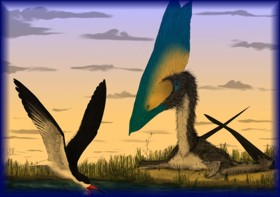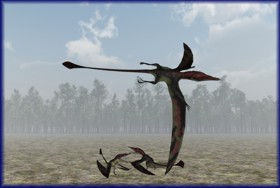|
Pick a feature, any feature will do
Harry Govier Seeley was nobody's fool. This august nineteenth century British paleontologist knew his dinosaurs as well as anybody else in his time. In the never-ending quest to classify living (or once-living) things, paleontologists had been trying to figure out what characteristics of anatomy should be used for divvying up dinos. Some had argued for using foot structure as the primary taxonomic criterion while others contended for using the form of teeth. Seeley came up with a criterion - the structure of the hip joint - for classifying dinosaurs into two major taxa. All dinosaurs had a pelvis that resembled either that of lizards or that of birds. His classification of dinosaurs into the orders Saurischia and Ornithischia based on this characteristic stands to this day. If the paleontology world beatified its greats, he would undoubtedly be known today as St. Seeley. Or would he? He may, by now, like St Simon in 1965, have had his sainthood revoked.
Why might the church of paleontology have unsanctified him? Because he preached that birds descended from flying pterosaurs. Silly man! Everybody today knows that birds descended from the same group of dinosaurs (Theropoda) as that which included Tyrannosaurus rex; we all are fully convinced that hummingbirds are much more like T. rex than they are like pterodactyls, aren't we? Even Seeley's predecessor, Thomas Huxley, had proposed dinosaurs as the ancestor of birds. Fact of the matter is, the wide variety of methods used by different evolutionists for determining evolutionary relationships shows just how tenuous the entire theory of evolution really is. Don't let Richard Dawkins's belligerent assertions that near universal consensus concerning kinship among living things is found among evolutionists fool you. Consensus among evolutionists - now or ever - over kinship between organisms is about as likely as a settlement of the Palestinian issue.
I ask: why don't evolutionists take another look at Seeley's contention? Even though evolutionists come closer to consensus over the origin of birds than over just about any other question of relationships, it seems to me that Seeley's theory has as much going for it as the birds-from-theropods theory. You see, theories of relationships are just that - theories. Kinship theories are based on subjective opinions of different evolutionists as to which shared features should be used as criteria for determining kinship. Be honest now. Does your everyday duck strike you as being more similar to T. rex or to a pterodactyl? I, for one, am on Seeley's side.
The birds-from-dinosaurs theory obviously has something going for it or it would never have flown. Yes, birds share some remarkable characters with theropods. For instance, the skeleton of Rahona ostromi, a crow-like bird that lived approximately 70 million years ago in Madagascar, "exhibits a striking mosaic of theropod and derived avian features", 1 including a sickle-like claw on the hind foot, "a unique characteristic of the theropod groups Troodontidae and Dromaeosauridae". More generally, the bones of theropods are characterized by hollow, thin-walled bones like those of birds. But hey, guess what! A detailed study of the bone microstructure of pterosaurs showed that,
All but Dimorphodon displayed highly vascularized fibro-lamellar cortical tissues that are extremely similar to those of birds such as the duck, the hawk and the guinea fowl. And, like birds, pterosaurs resorbed all but a thin shell of the outer cortex.2
And think about this: pterosaurs could fly while theropods. well. flying theropods are like flying spiders - they have never existed.
Sure, some theropods had feathers of sorts, as has been trumpeted triumphantly by evolutionists. But as Alan Feduccia and Theagarten Lingham-Soliar have pointed out, these are not really feathers at all. (See T. rex to hummingbirds.) And just to make matters worse for evol-
|
utionists, some scientists believe that the hairs found on pterosaurs are "one and the same thing" as the dino fuzz found on many theropods which is presumed to have evolved into the feathers they make such a fuss about 3. And as evolutionists continually try to tell us when they are presented with blanks in the fossil record that embarrass their position, the hypothesized links simply haven't been found yet. I say that it's only a matter of time before a pterosaur is found with not just fuzz but feathers!
O.K. I'll make a confession here. Proponents of the dinosaur-to-bird scheme note that birds and "advanced theropod dinosaurs" share about 100 anatomical similarities. I have no idea how many features can be said to be shared between pterosaurs and birds, but I would venture to suggest that since the pterosaur-to-birds theory is currently out of favor, nobody has bothered to try to catalog similarities. You may be wondering why the pterosaur-to-bird theory was abandoned in the first place. Unwin tells us that,
Pterosaurs. have numerous features in the construction of the skull and design of the hands and feet that resemble the condition in reptiles, but are completely different from those of birds, ruling them out from any close relationship to these feathered fliers (p. 64).
O.K. So it seems that theropods beat pterosaurs in having more bird-like hands and feet. But then, all theropods, unlike birds, had sharp, recurved teeth while many pterosaurs, like birds, had no teeth! Pick and choose, pick and choose - any feature you like.
One feature stands out, though, that dramatically favors Seeley's birds-from pterosaurs theory - the brain. Now would you not agree that one similarity in brain structure between organisms is worth a hundred similarities in hands and feet? A study of theropod brains shows that most of them have "a similar cerebrum-to-total-brain ratio as modern nonavian reptiles".4 In other words, their brains were more like modern lizard brains than bird brains. Sorry T. rex fans, but your hero could never have flown even if it had wings and feathers. Evolutionists "hypothesize" that the transition from reptile-like ratios in the brain to bird-like ratios "occurred at Coelurosauria and continued throughout the evolution of maniraptorans and early birds". True, Coelurosaurs had larger brains than their sister theropods, but the evidence does not seem to suggest that they had bird-like brains. (Humans have a large brain, too, but that doesn't make us bird-brained.) Here is where pterosaurs win the race hands down: they "had a relatively large, birdlike brain". 5
Now for the clincher, the timing. Don't you think it seems highly unlikely that a descendant would have arrived on the scene before its supposed ancestors. Well, that's exactly what the bird-from-theropod theory requires. The oldest real bird, the famous Archaeopteryx, lived around 135 million years ago while the very earliest "proto-feathered" theropod dinosaurs go back to only about 120 million years ago! Archaeopteryx, although sharing some features with later theropods also shared features with some pterosaurs, notably needle-like teeth and a long bony tail somewhat similar to the tail of Pterodactylus. And Pterodactylus goes back to at least 148 million years ago,6 making it a much more like ancestor of Archaeopteryx than much later theropods. Yessiree, were I to believe in evolution, my vote would go to Seeley.
Here's the point. Almost any shared feature - bones, molecules, or DNA bar code - can be called upon to "prove" a relationship between groups of organisms. It all depends on which theory you favor. Creation theory, by contrast, never has to shoehorn facts to fit the theory. Not a single fact of nature presents any obstacle to the notion of creation by a supremely intelligent and all-powerful creator.
|





